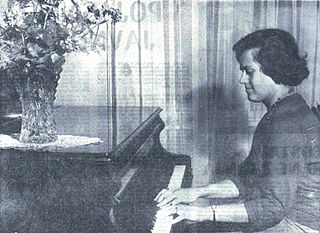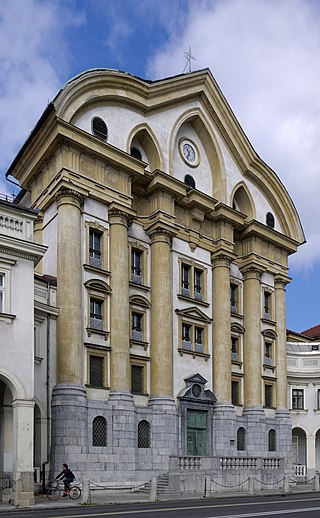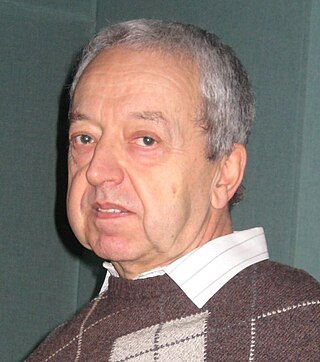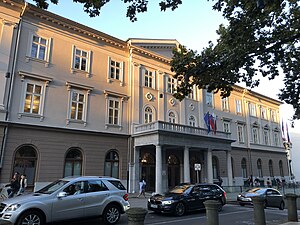The Academia Operosorum Labacensium —a forerunner of the modern Slovenian Academy of Sciences and Arts—was founded in Ljubljana in 1693 as an association of 23 scholars. Most of the members, which included 13 lawyers, six theologians, and four medical doctors, were ethnically Slovene. The newly founded library became an important centre of activity for its members. The Operosi were very influential in the development of the arts in Ljubljana and throughout the Slovene cultural area.

The University of Ljubljana, abbreviated UL, is the oldest and largest university in Slovenia. It has approximately 38,000 enrolled students. The university has 23 faculties and three art academies with approximately 4,000 teaching and research staff, assisted by approximately 2,000 technical and administrative staff. The University of Ljubljana offers programs in the humanities, sciences, and technology, as well as in medicine, dentistry, and veterinary science.
Nama, or NAMA, is the acronym for Narodni magazin 'national store'. This was a chain of department stores in the former SFRY (Yugoslavia) and the first Slovenian department store. Nama owns three stores in Slovenia today:

Radiotelevizija Slovenija – usually abbreviated to RTV Slovenija – is Slovenia's national public broadcasting organization.

Dubravka Tomšič Srebotnjak is a Slovenian pianist and music teacher.

Vinko Globokar is a French-Slovenian avant-garde composer and trombonist.
The Academy of Theatre, Radio, Film and Television is an academy of the University of Ljubljana in Ljubljana, Slovenia. It is the only college and graduate school in Slovenia with a similar curriculum. It is composed of three colleges: the College for Theatre and Radio, the College for Film and Television, and College for Screen and Play Writing. In addition, a Center for Theatre and Film Studies is included in the academy. The current dean is Aleš Valič.

The Metropolitan Archdiocese of Ljubljana is a Latin ecclesiastical territory or diocese of the Catholic Church in Slovenia.

The Slovenian Philharmonic Orchestra is a Slovenian orchestra based in Ljubljana. Its primary concert venues are Marjan Kozina Hall in Philharmonic Hall, Ljubljana, at Congress Square and Gallus Hall in the Cankar Centre at Republic Square in Ljubljana.

Ljubljana Town Hall is the town hall in Ljubljana, the capital of Slovenia, is the seat of the City Municipality of Ljubljana. It is located at Town Square in the city centre close to Ljubljana Cathedral.

Congress Square is one of the central squares in Ljubljana, the capital of Slovenia. In the late 1930s, the square was renovated by the prominent Slovene architect Jože Plečnik. Since August 2021, it has been inscribed as part of Plečnik's legacy on the UNESCO World Heritage List.

Ursuline Church of the Holy Trinity, officially Holy Trinity Parish Church in Ljubljana, also Nun Church, is a parish church in Ljubljana, the capital of Slovenia. It is located at Slovene Street, along the western border of Congress Square. It was built between 1718 and 1726 in the Baroque style.
Quartissimo was a Slovenian string quartet featuring Žiga Cerar on first violin, Matjaž Bogataj on second violin, Luka Dukarić on viola, and Samo Dervišić on cello. The group's name is a portmanteau of quartet and the Italian suffix -issimo, which means extremely.

Marjan Kozina was a Slovene composer. He is considered one of the most important Slovene composers of the 20th century. His best known works include a symphony, composed in stages through the late 1940s; the opera Equinox, completed in 1943; two ballets from the early 1950s, and the music for the film On Our Own Land, which he later arranged into a suite for orchestra.

Jani Golob is a Slovenian composer, violinist, arranger and professor.

The Ljubljana Slovene National Theatre Drama, or the Slovene National Theatre Drama in Ljubljana, is the national theatre in Ljubljana, Slovenia, best known for its conservative repertoire, including classical European dramatic texts and selected contemporary non-commercial European and Slovene ones. Its seat is the Ljubljana Drama Theatre to the southeast of the Slovene Museum of Natural History and southwest of the University of Ljubljana, at 1 Erjavec Street. It is an Art Nouveau building originally of the city's German Theatre.

Sts. Cyril and Methodius Church, commonly known as the Orthodox Church, is an Eastern Orthodox church building located in Trubar Park, between Bleiweis Street and Prešeren Street, north of the Museum of Modern Art and west of the National Gallery of Slovenia. It belongs to the Metropolitanate of Zagreb and Ljubljana of the Serbian Orthodox Church.

The International Centre of Graphic Arts in Ljubljana was established in 1986 to give the international Ljubljana Biennial of Graphic Arts - which itself has a longer, uninterrupted tradition from 1955 - its own place. Most of its history the director was Zoran Kržišnik.

The Casino Building is a Neoclassical building in the city centre of Ljubljana, the capital of Slovenia. It stands in the northwestern corner of Congress Square next to the crossroad of Slovene Street and Šubic Street. In the past, it was the meeting place of Ljubljana's higher social classes. Today the Casino Building houses several institutions, including the Institute of Modern History, the Archives of Slovenia, the France Marolt Academic Folklore Society, and the Tone Tomšič Academic Choir.

Grigor Palikarov is a Bulgarian conductor, composer, pianist and music educator.
















